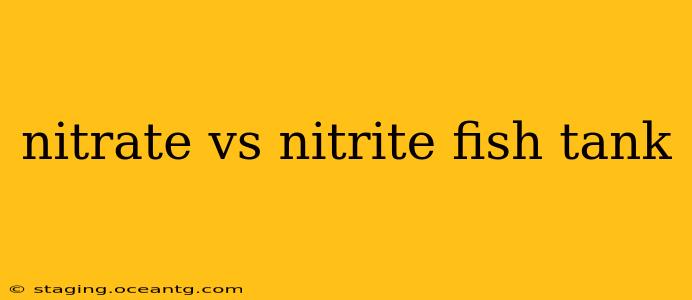Maintaining a healthy aquarium requires understanding the nitrogen cycle, a crucial process that converts harmful waste products into less harmful substances. Two key components of this cycle are nitrates (NO3) and nitrites (NO2). While both are nitrogen-containing compounds found in aquarium water, their impact on your fish is vastly different, making it crucial to understand the distinction. This guide will delve into the differences between nitrates and nitrites, explaining their roles in the aquarium environment and how to manage their levels.
What are Nitrates (NO3)?
Nitrates are the end product of the nitrogen cycle. They're significantly less toxic to fish than nitrites, though high concentrations can still be harmful. Plants readily absorb nitrates as a nutrient, making them beneficial for a planted aquarium. However, excessive nitrates can lead to algae blooms and other water quality issues. Regular water changes are the primary method of controlling nitrate levels.
What are Nitrites (NO2)?
Nitrites are an intermediate product in the nitrogen cycle, formed from the breakdown of ammonia (NH3), a highly toxic substance produced by fish waste and uneaten food. Nitrites are far more toxic to fish than nitrates, capable of causing severe health problems, including death, even at relatively low concentrations. A properly established nitrogen cycle relies on beneficial bacteria to convert nitrites into nitrates.
What is the Nitrogen Cycle?
The nitrogen cycle is a series of biological processes that transform nitrogenous waste into less harmful compounds. Here's a simplified explanation:
- Ammonia (NH3): Fish waste and decaying organic matter produce ammonia, a highly toxic substance.
- Nitrite (NO2): Nitrosomonas bacteria convert ammonia into nitrites, which are also toxic, though less so than ammonia.
- Nitrate (NO3): Nitrobacter bacteria convert nitrites into nitrates, the least toxic form of nitrogen in this cycle.
- Nitrate Removal: Water changes, and in planted tanks, plant uptake remove nitrates from the water.
How to Test for Nitrates and Nitrites
Regular water testing is essential to monitor nitrate and nitrite levels. Use a reliable liquid test kit or test strips to obtain accurate readings. These tests will provide measurements in parts per million (ppm) or milligrams per liter (mg/L).
What are safe levels of nitrates and nitrites in a fish tank?
- Nitrates: Ideally, nitrate levels should be kept below 20 ppm. Levels above 40 ppm can become problematic, requiring water changes.
- Nitrites: Nitrite levels should ideally be 0 ppm. Any detectable amount of nitrite is a sign of an incomplete or malfunctioning nitrogen cycle.
How to lower nitrate levels in a fish tank?
- Regular Water Changes: Performing partial water changes (25-50% of the tank volume) weekly helps remove accumulated nitrates.
- Increase Filtration: Ensure your filter is adequately sized for your tank and is properly maintained.
- Live Plants: Live plants consume nitrates as a nutrient, helping to reduce their concentration.
How to fix high nitrite levels in a fish tank?
High nitrite levels indicate a problem with the nitrogen cycle. Addressing this requires a multifaceted approach:
- Check for a cycle: If your tank is new, it's likely undergoing cycling. Be patient, it takes time (several weeks or longer).
- Inspect your filter: A clogged or malfunctioning filter will hinder the bacteria's ability to convert nitrites. Clean or replace filter media as needed.
- Increase aeration: Sufficient oxygen levels are crucial for the bacteria responsible for nitrite conversion.
- Large water change: Do a large water change (50% or more) to immediately reduce nitrite levels, but follow this with regular smaller changes.
- Consider a bacterial supplement: Some products contain beneficial bacteria that can assist in establishing or re-establishing the nitrogen cycle. Follow product instructions carefully.
What happens if my fish are exposed to high levels of nitrites or nitrates?
Exposure to high nitrite levels can cause stress, lethargy, loss of appetite, and respiratory problems in fish. High nitrate levels can lead to chronic stress, reduced immunity, and susceptibility to disease. In severe cases, both can be fatal.
Understanding the difference between nitrates and nitrites, and maintaining healthy levels of both, is fundamental to successful aquarium keeping. Regular testing and prompt action to address imbalances are key to ensuring the health and well-being of your aquatic companions.
